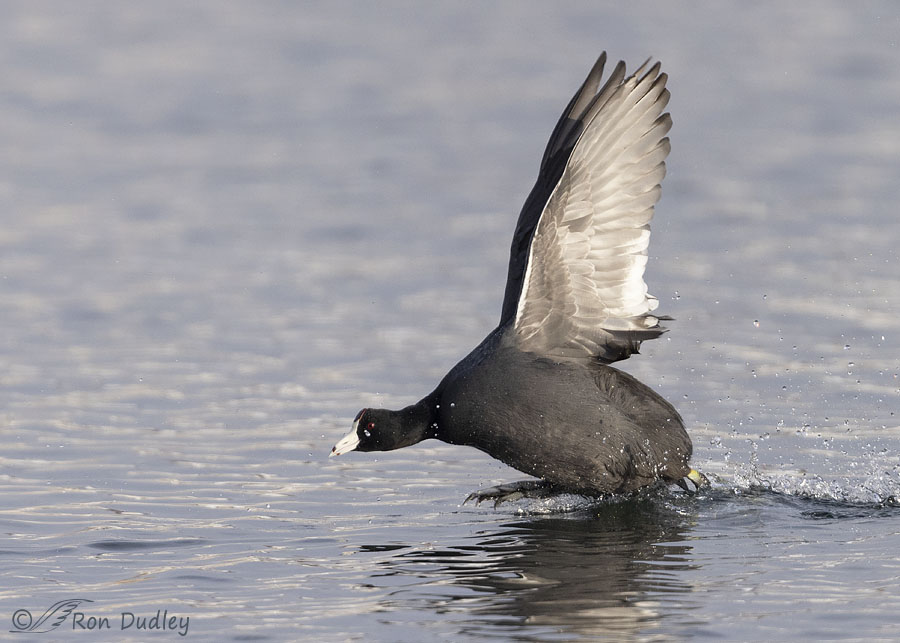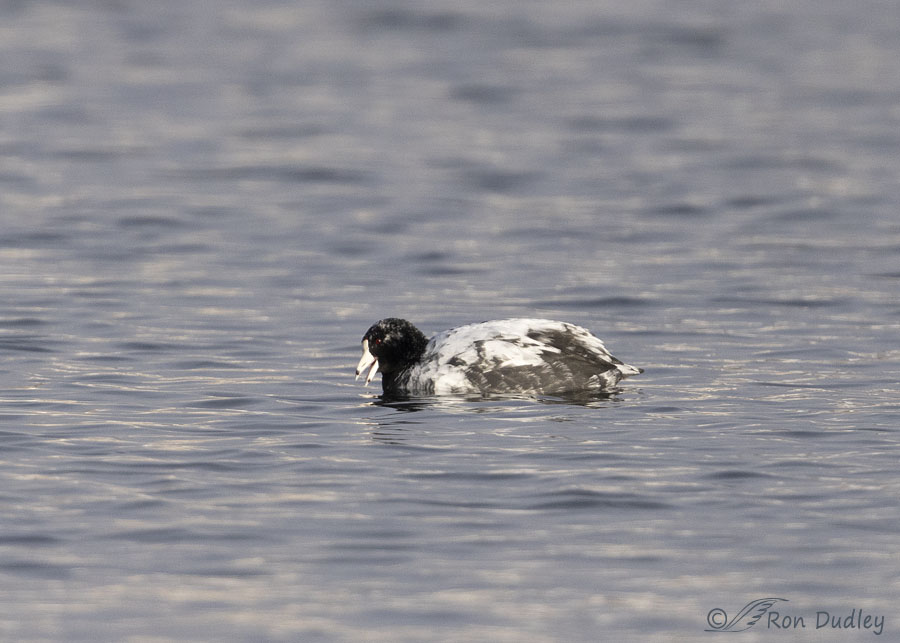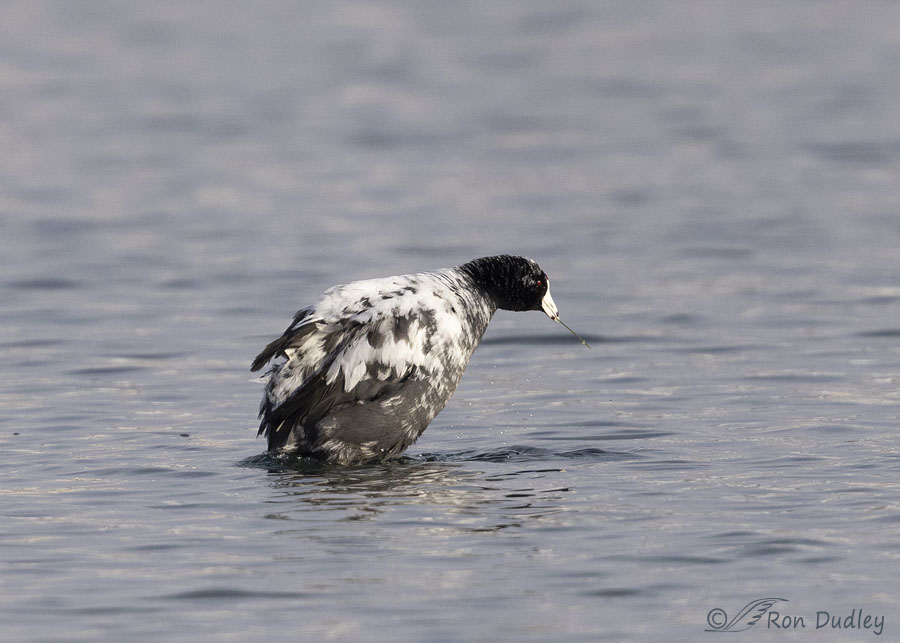Lately my life has been dominated by doctor and physical therapy appointments at the hospital, daily PT sessions at home, down time while I’m recovering from PT and trying to get through endless days on end of clouds, snow and really poor light for photography. On those rare occasions when we’ve had some brief breaks in the clouds I always seem to have had some kind of appointment, including one a few days ago to get my pickup’s oil changed. At least that’s done, finally.
But the spell was broken late yesterday afternoon when we got a sucker hole in the clouds and I didn’t have any other commitments so I visited one of the ponds I frequent to see if I might get lucky.

1/4000, f/5.6, ISO 800, Canon R5, Canon EF500mm f/4L IS II USM + 1.4 tc, not baited, set up or called in
The most interesting shots I got were of American Coots. This is the time of year they start to get frisky with each other so I concentrated on trying to photograph them during their brief but intense skirmishes. Of the shots I got I liked this one best as the angry coot chased off another coot, out of frame to the left, that it thought had infringed on its feeding territory.
I’m including this photo for two reasons. I think it’s a pretty good action shot and it shows what a normal coot (if there’s such a thing as a “normal” coot) looks like – in contrast to the next coot I photographed which was anything but normal.

1/4000, f/5.6, ISO 800, Canon R5, Canon EF500mm f/4L IS II USM + 1.4 tc, not baited, set up or called in
It was a dramatically leucistic coot out in the middle of the pond. It never did come in close so these photos have been cropped significantly but it was close enough for me to document its unique coloring reasonably well.
This photo shows the highly unusual colors and patterns on its left side and…

1/4000, f/5.6, ISO 800, Canon R5, Canon EF500mm f/4L IS II USM + 1.4 tc, not baited, set up or called in
this one documents those on its right side and flank. Yes, there’s a twig in its bill.
It’s the strangest looking coot I’ve ever seen, that’s for sure.
Ron


Happy New Year, Ron. The second coot puts me in mind of a ptarmigan changing plumage. Very interesting to see.
Thanks, Nina. You’re right about the ptarmigan.
That coot is really cool. 😀 Sending good PT results to you~
Thanks on both counts, Arwen.
Happy New Year, Ron! Hope it brings you excellent results PT-wise and photo-wise … we’re all looking forward (as I know you are) to the renewed you!
That leucistic coot reminds me of a juvenile Bald Eagle, like their feathers can’t decide if they should be dark or light. Hope this one finds its place in the world.
“That leucistic coot reminds me of a juvenile Bald Eagle”
Chris, I hadn’t thought of that but you’re right.
And yes, I hope the “renewed me” comes along soon.
As if Coots, with their green lobed feet, red eyes, and pied bill weren’t interesting enough, the leucisim puts this one over the top.
PT and oil changes. Preventive maintenance.
“Preventive maintenance”
Yup. Both have to be done but one’s a lot more bother than the other.
What an amazing find! And another avian/bio lesson learned.
Thanks Ron. Sorry to hear you are so occupied and vexed by these physical issues. Guess it’s the price of a long life. Good to get a post from you. All the best…
Much appreciated, Michael.
When I saw Mia’s blog yesterday I was hoping that you’d get a chance to see the “Snowy Coot.” So glad you did and hope you get many more opportunities with this looker.
My classroom Corn Snake, Bob, was leucistic — such unusual coloring. I “inherited” him from a student who couldn’t take care of him any more. He was a sweet boy (yes, we checked and no, he didn’t like it) who lived a pretty long life.
And as someone who’s done multiple knee rehabs (minor injury, then major injury 4 months later, then finally surgery 6 months later) in the past few years, I can definitely vouch for the PT! If your gait is off because of your knee, you’ll feel it in your back and neck for sure. 💗
Marty, your comment brought back memories of all the critters I inherited from students – particularly those whose mothers objected to their kid having them. One of them was a small but absolutely ferocious snapping turtle with a huge chip on its shoulder. I’ll never forget that one…
Are there any snapping turtles WITHOUT huge chips on their shoulders? 😉 (I generally said yes to the animals my students “donated,” but I might have drawn the line at a snapping turtle.)
After a couple of years I found some parents of one of my students who were visiting the area in eastern CO where the snapping turtle was originally found. They agreed to return it to something like its original habitat there.
And believe it or not, after two years I still had all of my appendages. It could have gone either way…
Of course, your PT is probably for your back as well. Hang in there! 💗
Marty, my knee is fine. It healed within 2 weeks. My PT is for my back.
Happy New Year. I’m so glad ypu had the opportunity to be out in the field again.
I’ve seen many leucistic birds but this is the first leucistic coot I’ve ever seen. I’ve never seen a photo of one before so this is really interesting. As to the question of how such birds interact with normal plumaged birds, from my experience, I’ve seen mostly normal interactions. The crows, juncos, robins, etc behave normally and mate with non-leucistic individuals. Many years ago we had a local pair of Red-tails that nested successfully for a number of years. One of the birds was normal and its mate was totally white (but not an albino). The biggest issue for these birds is that the lack of melanin will cause those feathers to be weaker and break more easily. They are also less resistant to chewing parasites and keratin-degrading bacteria. For birds spending most of their time in the air, like hummingbirds, the white feathers can be significantly eroded by friction with the air. Note that White Pelicans and Snow Geese have black primaries and secondaries and most long-distant migrants, like Western Tanager or Black-headed Grosbeaks have dark wings. It’s important to prevent as much damage as possible to tnose feathers. Birds like egrets are not long-distant migrants and move to non-breeding areas in a series of short hops, not one or a few extended flights. Most all white hummingbirds have their flight feathers so degraded or damaged that many will not survive until their first adult molt and therefore never survive to mate. This bird I would expect to be fine.
Dan, thanks for supplying all that interesting and relevant info!
Lovely to see FP in the in-box today! The little hints of sunshine in the water are welcome – it’s another grey day here in central Washington. And the coots are lovely, too. The leucistic one looks a bit like our back yard – patchy ground with snow covering.
Thinking of you as you power thru your PT!
“Thinking of you as you power thru your PT!”
I think it’s more like my PT powering through me, Carolyn. It kicks my butt. However, I do think it’s finally getting a little easier.
Neat coot! Nice you got out. Our sucker hole lasted 20 minutes. I think the clouds get stuck and bunched up on the mountains.
“Our sucker hole lasted 20 minutes”
Ours didn’t last much longer than that either, April. Better than nothing though…
It is a total delight to see a post from you today. I really, really hope that the positive results from your PT start to emerge. And grow.
And thank you for these very different photographs of a bird species I will probably not see. I hope the lonely leucist (probably not a word) continues to survive and thrive.
“I hope the lonely leucist continues to survive and thrive.”
I hope it does too, EC. I’ll be keeping an eye out for that bird. Maybe next time it will even come in closer.
Cute Coots!! And nice photos too!
Thanks, Joanne.
Thanks for the new word Ron and appreciate the wiki link! Entertaining photos! Pls hang in there with your PT – it will get you positive results. (Know from experience.)
Thanks, Kathleen. I sure hope you’re right.
Hi Ron,
Happy New Year! A friend of mine once suggested we form the Coot Appreciation Club of America, or CACA. Figured we could have sold lots of Tshirts and bumper stickers to members (“I’m in CACA”). Big donors would be in deep CACA, etc. There were other marketing ideas, some of which are not fit for print, but hopefully you get the picture. Somehow the idea never went any further (you’re welcome), but this morning’s post got me thinking…🤪
Cheers,
Dick
“hopefully you get the picture”
Yup, I get the picture Dick. And enjoy it!
I would gladly donate “Big Bucks” to that organization! Especially if the t-shirts included images of their feet. 😂
Ron, continued good wishes as your recovery progresses.
Coots are underappreciated, in my opinion. They are a challenge to photograph properly (thank you for continuing to show it CAN be done), their antics are entertaining, their breeding/territorial fights are ferocious and – those feet!
Every time I encounter a leucistic bird I do a double-take. “What the heck is that?” I’ve never seen a leucistic coot.
The New Year will bring us all challenges and opportunities. We hope your healing will be one of 2023’s highlights for you.
Thank you, Gary. I’ve only seen a very few leucistic birds of any species and this is the first leucistic coot I’ve photographed.
Happy New Year Ron and hopes that everything physical will heal for you. That is indeed a very leucistic looking Coot. I do not believe I have ever seen one here looking like this. Like you I have not been out much due to weather and lack of sufficient light.
” Like you I have not been out much due to weather and lack of sufficient light.”
It’s frustrating, isn’t it Everett.
Good to “see” you again this AM ! I agree that the skies have definitely been
very depressing lately–trying to remind myself of the water they’re bringing.
Re Judy’s wonder about animals “discriminating”against one of their number who shows unusual coloration, like the leucistic coot– that’s a really interesting
question– have you heard/read anything on that subject ? I hope the therapy
starts helping very soon…….
Kris, I haven’t researched the subject but I watched this coot pretty closely to see if it associated with any of the other coots like so many of the others have been doing lately. But this one seemed like a loner, at least while I was watching it. Whether or not it’s leucism had anything to do with it, I don’t know.
Thanks for introducing me to a new word! And I’m glad you’ve moved on to PT, even though I know it’s not a barrel of laughs. Hang in there. And Happy New Year!!!
Thanks, Sue. It isn’t even a thimble-full of laughs.
I had heard the term leucisim before because 2 of the 5 crows that regularly visit my feeder yard have smallish leucistic markings, (nowhere near the extent of your coot’s) but was certainly grateful for the link because, new to me, it isn’t ‘just a case of hereditary defective genes which I had assumed but has many different forms and causes including both recessive and dominant genes and apparently other anomalies too numerous to mention. As for Judy’s question, I can only speak to my own observation; the two leucistic crows in my yard seem to be well integrated into the group.
Sorry to hear these health issues continue to overwhelm your quality of life but hopefully there is an end in sight, as there surely will be for the dreary skies.
Granny Pat, I get the impression that leucism is fairly common in crows. And I appreciate your good wishes.
WOW! Certainly is “different”…….always wonder if leucistic critters are discriminated against…. 😉
PT no fun tho I liked the results of my one round with it for a hip. Hope it’s productive for you over time!
Weather has been decent here of late (relative to what we were having) and will continue into next week. Can always use more moisture BUT! 🙂
Judy, so far, positive results from PT have been slow in coming but I couldn’t even start PT until about 2 months after the surgery so that’s part of the reason why.